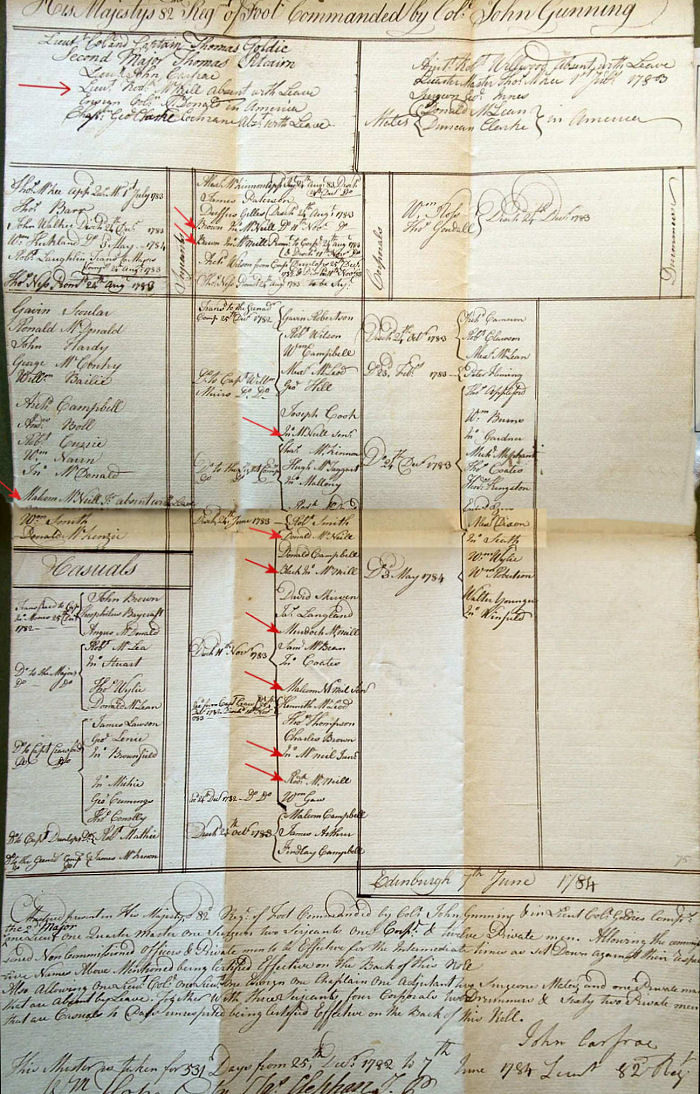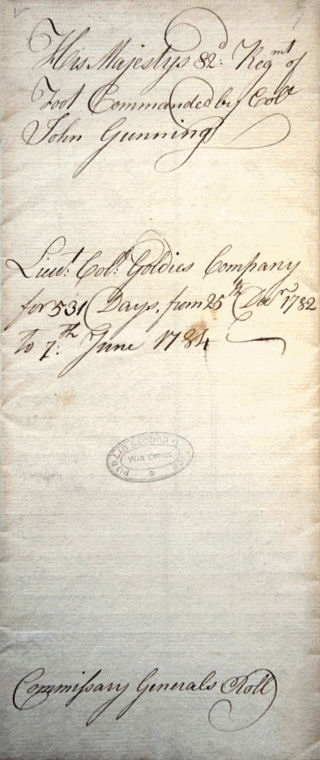|
Back to previous page
The Assembly of Indirect Evidence for RUAIRIDH BREAC MACNEIL — "THERE WAS A SOLDIER . . . ."
His MILITARY IDENTITY —
Was Ruairidh Breac recruited and brought to North America as a member of the British Army?
Many pioneer stories are told about Scottish soldiers who formed part of the brigade under General Wolfe during the French Wars that culminated in the fall of Quebec (1759). Roderick MacNeil of Barra, son of the Clan Chief, was killed in the battle on the Plains of Abraham; he was a lieutenant in the 78th Fraser's Highlanders,7 one of two regiments raised in the Highlands by Royal Warrant for that conflict. Many of the ordinary soldiers disbanded from Fraser's and from Montgomerie's regiments remained in Canada as immigrants following the Peace in 1763. Generally the land and settlement records of these immigrants have been well documented and traced by heritage, history and genealogy societies and there is no trace of this Barraman, Ruairidh Breac MacNeil in any of the sources.
About 15 years later, at the time of the American War, eight new or renumbered British Army regiments were recruited in the Highlands again, and all saw service in North America. There also were Scottish regiments that were augmented by pressing some Highland clansmen into them. Following the surrender at Yorktown in 1781, most regiments raised for this short-term service were disbanded, and, once more, many soldiers received grants of land in British North America as enticements to become settlers. For regular soldiers, aptly, these lots were chosen by drawing lots, and while the deeds for the regiment grant are preserved, there are no records of land that may have been left unclaimed, sold-off, bartered or gambled away. There is no evidence of a lot of land deeded to one Ruairidh MacNeil (or any spelling variant), that has survived in Nova Scotia land records.
The Muster Rolls of the British Army, 1732 to 1878, are indexed 8 and can be searched by regiment (WO12) and by name (WO25), although there is no guarantee that all the members are recorded in either the recruitment rolls or the discharge papers. Not all records were collected with fastidious attention to the Gaelic spellings. The search for a Ruairidh or Roderick (anglicized) MacNeil 9 as an enlisted man in any one of the
regiments raised for the American War is much like searching for a rare species of sparrow. The only reasonable genealogical method is the process of elimination, and this is never satisfactory as many of the lists survive only in fragments and in some instances may be housed in archives and regimental museums apart from the national repositories. Research in the muster rolls, attestation papers, discipline, discharge papers and pension documents in the War Office indices and files at the British National Archives and at the National Archives of Scotland offers merely a glimmer of hope as to the existence of one Ruairidh Breac from Barra.
The regiment that appears to hold his identity is the 82nd (Duke of Hamilton's) Regiment of Foot which was recruited in Lanarkshire (just west of Glasgow) for service in the American Revolution in 1778,10 and although it was a Lowland regiment, it included a fairly large corps of Highlanders. During the war, various companies of the regiment were merged with other companies in brigades, some of which were engaged in the southern American states (through the port of New York) and some in Maine and Massachusetts, generally based in the Halifax citadel, Nova Scotia. The Halifax disbandment papers reveal seven men under the surname 'McNeil': Donald, Murdoch, Matthew, and four Johns.11
Below is a transcription of a part of the table that appears in The Pictou Book: Stories of Our Past, by George MacLaren, page 74-75. The list was composed apparently by MacLaren based on the "List of Grantees of the 82nd Regiment" published by George Patterson in 1877.12 Patterson named the McNeil men in the order as they are in this table, and he added the notation, "Isle of Barra men, most of whom removed to Antigonish County."
|
| Name | Date | Situation | Acres | Rank |
McNeil, Donald
McNeil, John
McNeil, John
McNeil, John Jr.
McNeil, Matt
McNeil, Murd
McNeil, John Jr.
McPherson, James
McPherson, John
McQueen, Alexander
McVie, William | 1785
1785
1785
1785
1785
1785
1785
1785
1785
1785
1785 | Merigumish
Merigumish
Merigumish
Merigumish
Merigumish
Merigumish
Merigumish
Merigumish
Merigumish
Merigumish
Merigumish | 100
300
100
100
100
100
200
100
100
100
200 | Private, 82nd Regt.
Corporal, 82nd Regt.
Private, 82nd Regt.
Private, 82nd Regt.
Private, 82nd Regt.
Private, 82nd Regt.
Corporal, 82nd Regt.
Private, 82nd Regt.
Private, 82nd Regt.
Private, 82nd Regt.
Corporal, 82nd Regt. |
The disengagement that began in 1783, following the surrender, resulted in the disbandment of a large contingent in
Nova Scotia and the remainder of the force mustered out in Stirling, Scotland. Ostensibly, the regiment was struck and the troops disbursed by the late autumn of 1783.13 Most notably in the 82nd's history, a transport carrying 300 members was lost at sea off the New Jersey coast in the spring of 1782. Only 18 of the soldiers aboard survived that disaster—and only by clinging desperately to the rigging of the stricken vessel.14
Yet in the National Archives at Kew, there is a "Commissary Generals Roll" for "His Majestys 82nd Regmt of Foot commanded by Col John Gunning".15 It was written and signed in Edinburgh, Scotland in June 1784, and it is catalogued now in War Office documents [WO12/8597] at the archives (TNA, Kew). The document comprises a tally that is to be sent forward for payment, for accounts. Officially, it is the return of "Lieut. Col Goldie's Company for 531 Days, from 25th Dec 1782 to 7th June 1784", and in genealogical terms it is solid gold. This muster roll provides the written record that establishes a military identity for a Ruairidh (Roderick) McNeil, who appears likely to be Ruairidh Breac. As an added bonus, it finds the Clan Chief, MacNeil of Barra — Lt. Roderick McNeil. He was son of the Lt. Roderick McNeil (Roderick the Resolute) killed at the battle for the Plains of Abraham at Quebec, 13th September 1759. The Lt. Roderick McNeil in the 82nd Regiment had become Chief in 1763 on the death of his grandfather.16
The 82nd is a difficult regiment to trace through all the battles and harbours and fields of the American Revolution as the battalion never served as a unified corps. It was named "The Hamilton's" after the regiment sponsor rather than "McLean's",17 the regiment commander, the usual custom. The 82nd was split and companies were seconded into other regiments temporarily. At least five companies were called forward to the southern campaign and were held when Cornwallis surrendered at Yorktown. It appears that this muster roll is the only document that has survived which deals exclusively with Hamilton's 82nd Regiment.
Ten or eleven of the men who are tallied here on this lone scroll of men, a pay list actually for the last of the 82nd, are McNeils. For some, because of repetition, an identifier was added in the interests of army clarification: Jno McNeil Jun; Jno McNeil Sen; Black Jno McNeil; Brown Jno McNeil. Red arrows have been superimposed on the digital image of the document (below) in order to count the number of Mc/MacNeil men on the muster roll.
The images above and below are prints of digital photographs taken at the National Archives (formerly the Public Records Office) at Kew, Surrey, England. The records searched were 'General Muster Books and Pay Lists' [WO12 (1732-1878)]. WO12/8597 is the muster of the 82nd Regiment of Foot for the period 1777-1784, and is the only one archived in this series for this regiment. The researcher and photographer was R. W. O'Hara, Kew, Surrey. The larger image is a composite of two photographs—for which, my thanks to John Ball, Ystalyfera, South Wales.  |
Continue . . .
|

